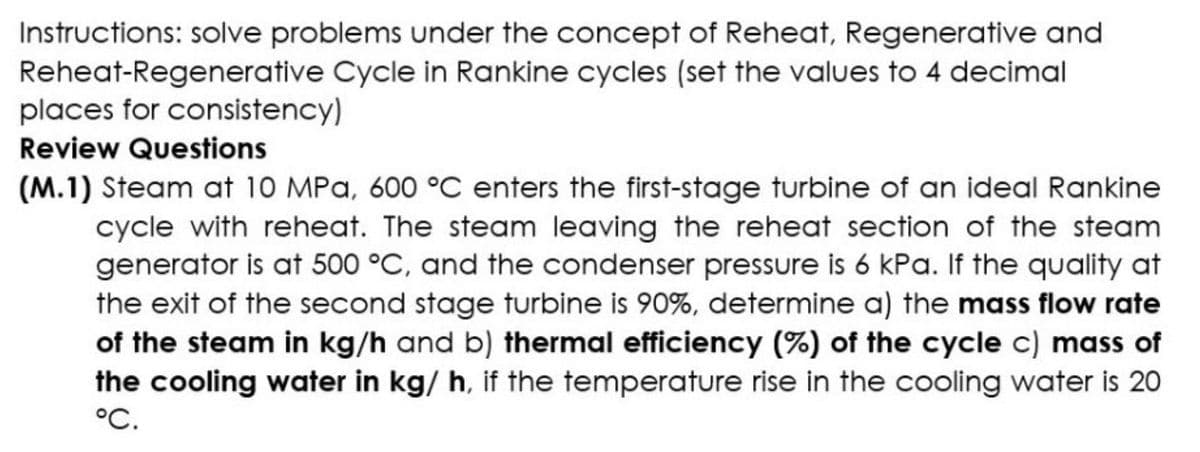Instructions: solve problems under the concept of Reheat, Regenerative and Reheat-Regenerative Cycle in Rankine cycles (set the values to 4 decimal places for consistency) Review Questions (M.1) Steam at 10 MPa, 600 °C enters the first-stage turbine of an ideal Rankine cycle with reheat. The steam leaving the reheat section of the steam generator is at 500 °C, and the condenser pressure is 6 kPa. If the quality at the exit of the second stage turbine is 90%, determine a) the mass flow rate of the steam in kg/h and b) thermal efficiency (%) of the cycle c) mass of the cooling water in kg/ h, if the temperature rise in the cooling water is 20 °C.
Instructions: solve problems under the concept of Reheat, Regenerative and Reheat-Regenerative Cycle in Rankine cycles (set the values to 4 decimal places for consistency) Review Questions (M.1) Steam at 10 MPa, 600 °C enters the first-stage turbine of an ideal Rankine cycle with reheat. The steam leaving the reheat section of the steam generator is at 500 °C, and the condenser pressure is 6 kPa. If the quality at the exit of the second stage turbine is 90%, determine a) the mass flow rate of the steam in kg/h and b) thermal efficiency (%) of the cycle c) mass of the cooling water in kg/ h, if the temperature rise in the cooling water is 20 °C.
Elements Of Electromagnetics
7th Edition
ISBN:9780190698614
Author:Sadiku, Matthew N. O.
Publisher:Sadiku, Matthew N. O.
ChapterMA: Math Assessment
Section: Chapter Questions
Problem 1.1MA
Related questions
Question

Transcribed Image Text:Instructions: solve problems under the concept of Reheat, Regenerative and
Reheat-Regenerative Cycle in Rankine cycles (set the values to 4 decimal
places for consistency)
Review Questions
(M.1) Steam at 10 MPa, 600 °C enters the first-stage turbine of an ideal Rankine
cycle with reheat. The steam leaving the reheat section of the steam
generator is at 500 °C, and the condenser pressure is 6 kPa. If the quality at
the exit of the second stage turbine is 90%, determine a) the mass flow rate
of the steam in kg/h and b) thermal efficiency (%) of the cycle c) mass of
the cooling water in kg/ h, if the temperature rise in the cooling water is 20
°C.
Expert Solution
This question has been solved!
Explore an expertly crafted, step-by-step solution for a thorough understanding of key concepts.
This is a popular solution!
Trending now
This is a popular solution!
Step by step
Solved in 2 steps with 1 images

Knowledge Booster
Learn more about
Need a deep-dive on the concept behind this application? Look no further. Learn more about this topic, mechanical-engineering and related others by exploring similar questions and additional content below.Recommended textbooks for you

Elements Of Electromagnetics
Mechanical Engineering
ISBN:
9780190698614
Author:
Sadiku, Matthew N. O.
Publisher:
Oxford University Press

Mechanics of Materials (10th Edition)
Mechanical Engineering
ISBN:
9780134319650
Author:
Russell C. Hibbeler
Publisher:
PEARSON

Thermodynamics: An Engineering Approach
Mechanical Engineering
ISBN:
9781259822674
Author:
Yunus A. Cengel Dr., Michael A. Boles
Publisher:
McGraw-Hill Education

Elements Of Electromagnetics
Mechanical Engineering
ISBN:
9780190698614
Author:
Sadiku, Matthew N. O.
Publisher:
Oxford University Press

Mechanics of Materials (10th Edition)
Mechanical Engineering
ISBN:
9780134319650
Author:
Russell C. Hibbeler
Publisher:
PEARSON

Thermodynamics: An Engineering Approach
Mechanical Engineering
ISBN:
9781259822674
Author:
Yunus A. Cengel Dr., Michael A. Boles
Publisher:
McGraw-Hill Education

Control Systems Engineering
Mechanical Engineering
ISBN:
9781118170519
Author:
Norman S. Nise
Publisher:
WILEY

Mechanics of Materials (MindTap Course List)
Mechanical Engineering
ISBN:
9781337093347
Author:
Barry J. Goodno, James M. Gere
Publisher:
Cengage Learning

Engineering Mechanics: Statics
Mechanical Engineering
ISBN:
9781118807330
Author:
James L. Meriam, L. G. Kraige, J. N. Bolton
Publisher:
WILEY